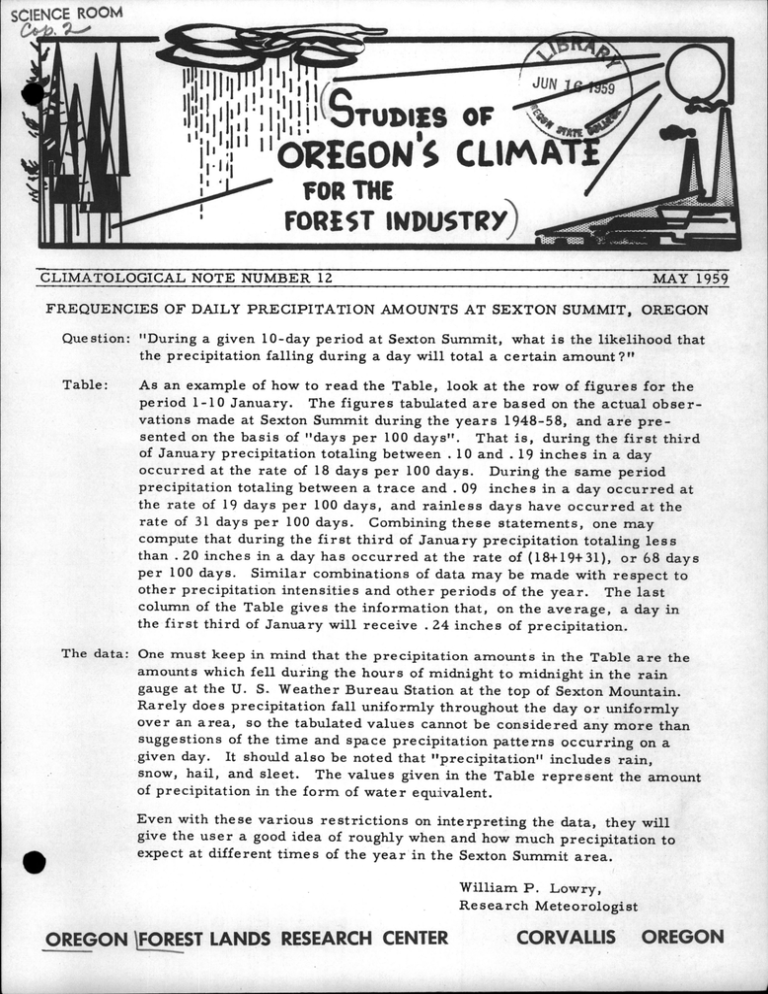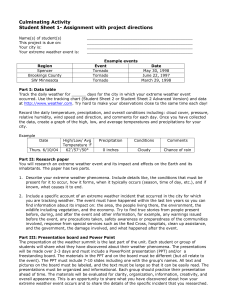SCIENCE ROOM
advertisement

SCIENCE ROOM CLIMATOLOGICAL NOTE NUMBER 12 MAY 1959 FREQUENCIES OF DAILY PRECIPITATION AMOUNTS AT SEXTON SUMMIT, OREGON Question: "During a given 10-day period at Sexton Summit, what is the likelihood that the precipitation falling during a day will total a certain amount?" Table: As an example of how to read the Table, look at the row of figures for the period 1-10 January. The figures tabulated are based on the actual obser vations made at Sexton Summit during the years 1948-58, and are pre sented on the basis of "days per 100 days'*. That is, during the first third of January precipitation totaling between . 10 and . 19 inches in a day occurred at the rate of 18 days per 100 days. During the same period precipitation totaling between a trace and . 09 inches in a day occurred at the rate of 19 days per 100 days, and rainless days have occurred at the rate of 31 days per 100 days. Combining these statements, one may compute that during the first third of January precipitation totaling less than . 20 inches in a day has occurred at the rate of (18+19+31), or 68 days per 100 days. Similar combinations of data may be made with respect to other precipitation intensities and other periods of the year. The last column of the Table gives the information that, on the average, a day in the first third of January will receive . 24 inches of precipitation. The data: One must keep in mind that the precipitation amounts in the Table are the amounts which fell during the hours of midnight to midnight in the rain gauge at the U. S. Weather Bureau Station at the top of Sexton Mountain. Rarely does precipitation fall uniformly throughout the day or uniformly over an area, so the tabulated values cannot be considered any more than suggestions of the time and space precipitation patterns occurring on a given day. It should also be noted that "precipitation" includes rain, snow, hail, and sleet. The values given in the Table represent the amount of precipitation in the form of water equivalent. Even with these various restrictions on interpreting the data, they will give the user a good idea of roughly when and how much precipitation to expect at different times of the year in the Sexton Summit area. William P. Lowry, Research Meteorologist OREGON FOREST LANDS RESEARCH CENTER CORVALUS OREGON < Q o o Oj W ft to >* < Q a w z o a aft 8 2 w o H 2 t> C/5 2 H o X w 00 H < H w Z >- is nj u ft A cro o 00 oo r- r- o o ga in o o cr- * ro O 0» 1 CM N o cr- i—i O 1 0» o o "" ,H , °:.s Q £ . '•j H (U <i P O "^J 2 H HH U « H •—t t-l U § Q tM CO 00 ' f vO o- "^ i- i1 ,-t CO r- ~< cm •* m —i ^^ in —« M m pi CT- m .tfi gD O- CO * •* * v£> h- N CO CM * CM -. o o in o in o 00 o in ro CM g3 O o ro in i CM CM eg —I O —I O (VJ H 0 o * o s> rg —i o rg ro ro in <vj rg O f•—i cr- ro •—' rg —i rg gD rg * r-> rr-t m ro ro * r- oo * —i r- * o —i * NO* gD -i oo in r- CO CO o OO CO in CO (M —i in ro O r- in CM CO -> in m vO —i O * so to o in m in o ro co gD o rg in * rg o rg —i o o r- o i ro rg r- oo o i (M * in o • -» rg oo H i co o 00 o —< ro in * O o r- oo O <-* cm ro (\) N o in O r-< M o ro ro in co O o O o oo CM CM * 00 -t O i -< • ro & XI z o a OJ XI CM XI V u > O o oj o N o CM g} O o r-i li 43 cu -< * r-l ro 00 0) o ^1 O O 1M in sD v£) O pH rrj 2 o ro n o * CM N o o o in CM in in * -. r- m ro in Tf o * ro o * ^ ro oo ro o ro * o m N CO ro jj N vj-j ro a o CM o -J 2 rrj O CM r-l ro m CM o CM o o r - ' * ao in vD in 00 rt n vO ro IMfl h n o a* O ro ro ro CM so ro o (M ro * O ro —i CM —( -I N XI rd O O M pH ro O —i a 9 u ft



